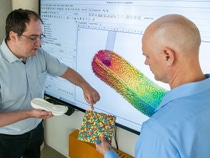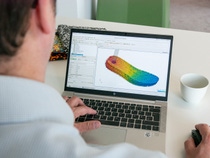Media
Particle foam perfectly distributed thanks to simulation with Ultrasim®
- Ultrasim® simulation now available for manufacturing processes of particle foam components
- Application starts with expanded thermoplastic polyurethane (E-TPU) Infinergy®
- The new application expands BASF’s proven simulation portfolio for innovations in plastics
BASF is expanding its proven Ultrasim® simulation portfolio for plastics applications: From now on, the simulation competence will also cover the manufacturing process of components made of particle foam. Customers can use Ultrasim® to accelerate the development process for their components and save costs.
From bicycle tires to shoe soles: Simulation for components made of Infinergy®
The new Ultrasim® solution was developed for Infinergy®, an expanded thermoplastic polyurethane (E-TPU), which is used in a wide range of applications. “Whether in bicycle tires or shoe soles, particle foams such as Infinergy® usually use pneumatic filling,” says Achim Besser, Team Leader Ultrasim® Core. “This means that the particles are distributed in the mold with the help of compressed air. But how can potential problems in the manufacturing process already be identified in the development stage of the component? That’s exactly where Ultrasim® will help from now on.”
The new simulation competence covers the entire manufacturing process of components made of particle foam, as Moritz Höfert, Simulation Engineer, adds: “Which path does the air take into the mold and out again? Should the customer change the venting of the mold or the placement and number of fillers to avoid air pockets? Is gravity used optimally? How does closing the mold change the particle packing? And finally, how does the finished part perform under load?”
“If our customers know the answers to these questions, they can fully leverage the potential of particle foams,” Martin Vallo, Senior Manager Global Tech Development, affirms. “For example, in a shoe midsole, the filling affects the density and stiffness of the sole. Ultrasim® simulation can optimize these two parameters - and fully exploit the potential of Infinergy®.”
The new application was initially developed for the E-TPU Infinergy®. Click here to find out more. The simulation expertise can be transferred to other particle foams and thus enables an evaluation of which particle foam is best suited for the planned component. For all information about BASF’s complete Ultrasim® portfolio, please visit: www.ultrasim.basf.com.
About BASF
At BASF, we create chemistry for a sustainable future. We combine economic success with environmental protection and social responsibility. More than 111,000 employees in the BASF Group contribute to the success of our customers in nearly all sectors and almost every country in the world. Our portfolio comprises six segments: Chemicals, Materials, Industrial Solutions, Surface Technologies, Nutrition & Care and Agricultural Solutions. BASF generated sales of €87.3 billion in 2022. BASF shares are traded on the stock exchange in Frankfurt (BAS) and as American Depositary Receipts (BASFY) in the United States. Further information at www.basf.com.
About BASF’s Performance Materials division
BASF’s Performance Materials division is at the forefront of the much-needed sustainability transformation in plastics. Our products are co-created with customers around the globe to bring innovations to four major industry sectors – transportation, consumer goods, industrial applications, and construction. Our R&D focuses on all stages of the plastics journey: Make, Use and Recycle. The MAKE phase is about improving how plastics are made, from product design to the choice of raw materials and the manufacturing process itself. The USE phase enhances plastics’ strengths such as light weight, robustness, and thermal resistance. At the end of the product lifecycle, the RECYCLE phase looks at how to close the loop to achieve a circular economy. In 2022, the Performance Materials division achieved global sales of €8.5 billion. Join #ourplasticsjourney at: www.plastics.basf.com
P-23-353


